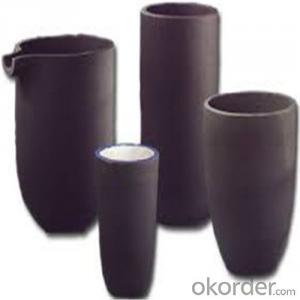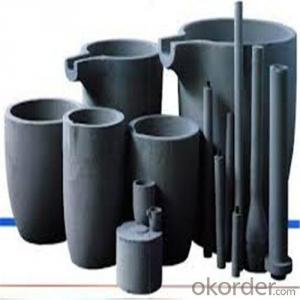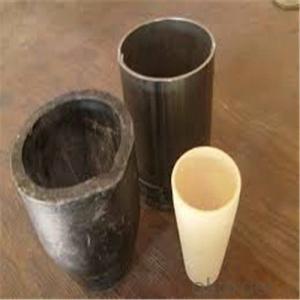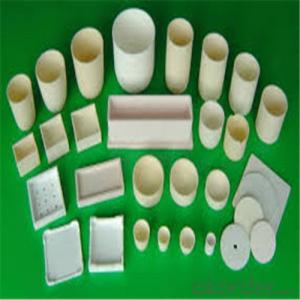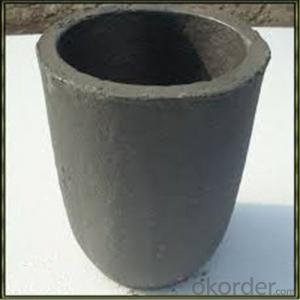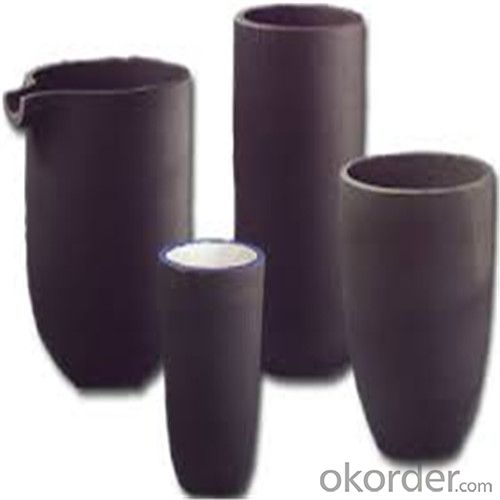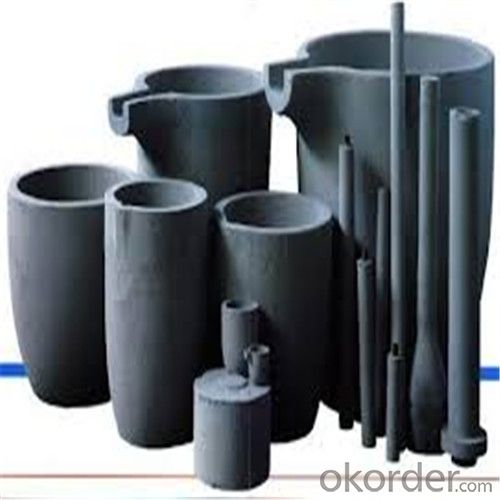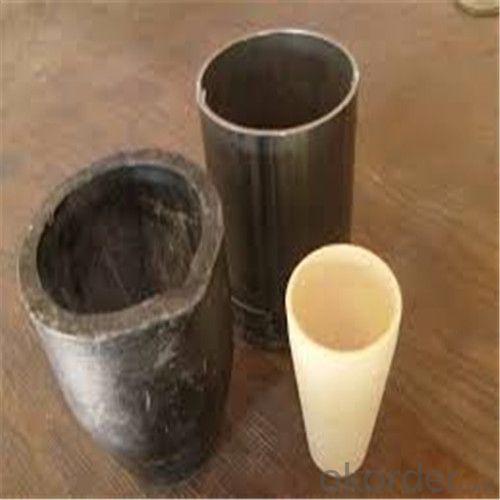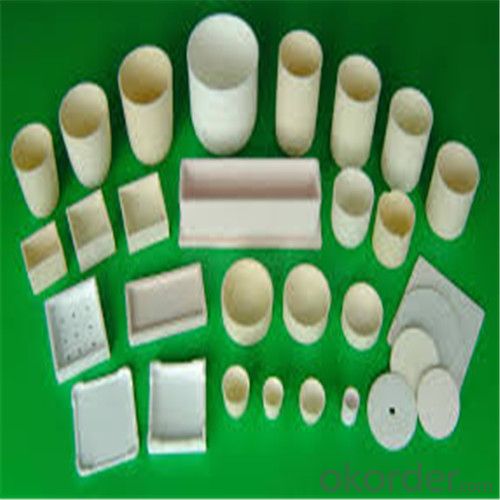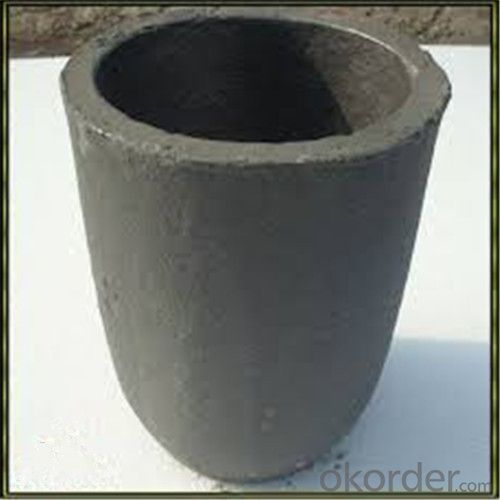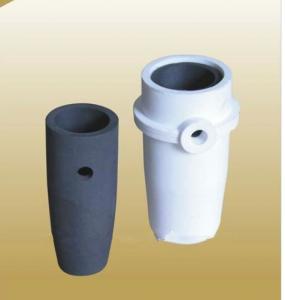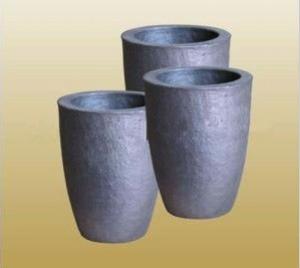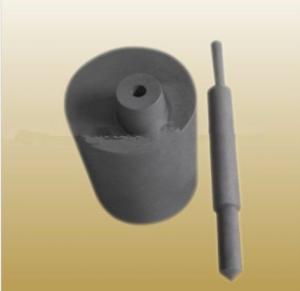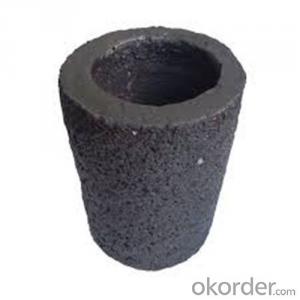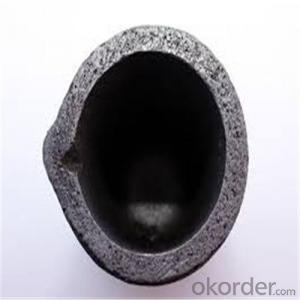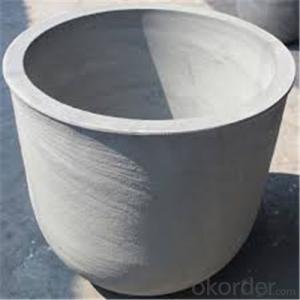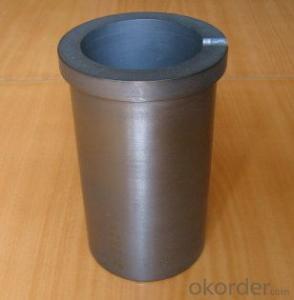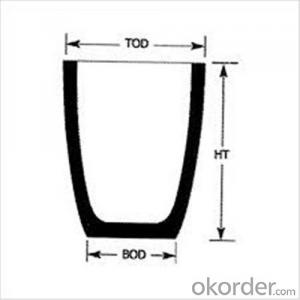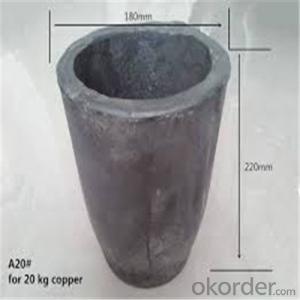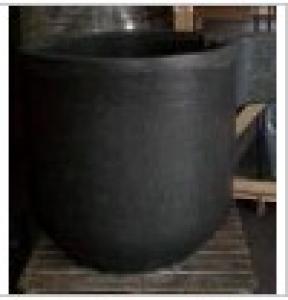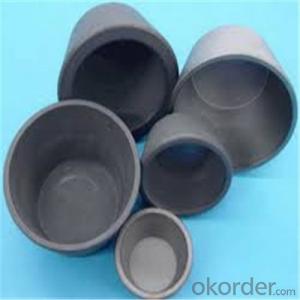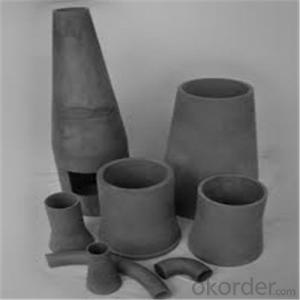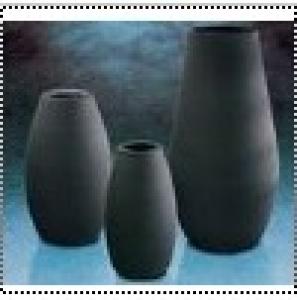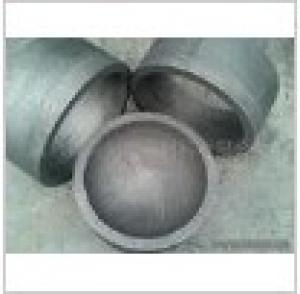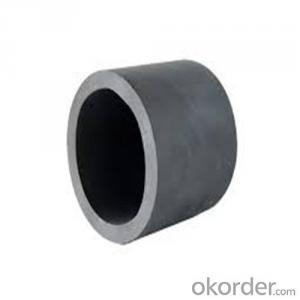Silicon Graphite Crucible for Melting Aluminium, Copper, Brass
- Loading Port:
- Shanghai
- Payment Terms:
- TT OR LC
- Min Order Qty:
- 1 pc
- Supply Capability:
- 1000 pc/month
OKorder Service Pledge
OKorder Financial Service
You Might Also Like
Quick Details for SiC Graphite Crucibles
| Type: | High Strength, graphite crucible crucible | Application: | melting metal | Height: | as your requirements |
| Composition: | High Pure | Top Diameter: | 10-600mm | Bottom Diameter: | 10-1000mm |
| Place of Origin: | China (Mainland) | Brand Name: | Model Number: | ||
| Color: | Black grey | Si3N4%: | 5min | Fe2O3%: | 0.7max |
| C%: | 30-45 | Apparent porosity: | 30max | Refractoriness: | 1680 |
| Bulk Density: | 1.71min | Using life: | >5000 hours | MAX temperature: | 1600c |
Packaging & Delivery
| Packaging Details: | Seaworty packing or as per customer's detail requirement of graphite crucible. |
| Delivery Detail: | within 20-30 days after confirm order of graphite cru |
SiC Graphite Crucibles For Melting Aluminium And Copper, Brass
Product Description
Specifications for Graphite Silicon Carbide Crucible For Aluminum Melting :
1.Long working lifetime: its working lifetime is increased 3-5 times over normal clay-crucible due to the compact body formed under high pressure.
2.High thermal conductivity: high-density body and low apparent porosity greatly improve its heat conductivity.
3.New-style materials: new heat conduction material ensures faster heat conductivity and pollution-free product, reduces adherent slag.
4.Resistance to corrosion:better anti-corrosion than normal clay-crucible.
5.Resistance to oxidation: advanced process dramatically improves its oxidation resistance, which ensures persistent heat conductivity and long working lifetime.
6.High-strength: high-density body and logical structure make the product better compression property.
7.Eco-friendly: energy-efficient and pollution-free, not only ensure metal product purity, but also ensure sustainable development on environment.
8.Multi-function: Can be used in induction graphite crucible furnace
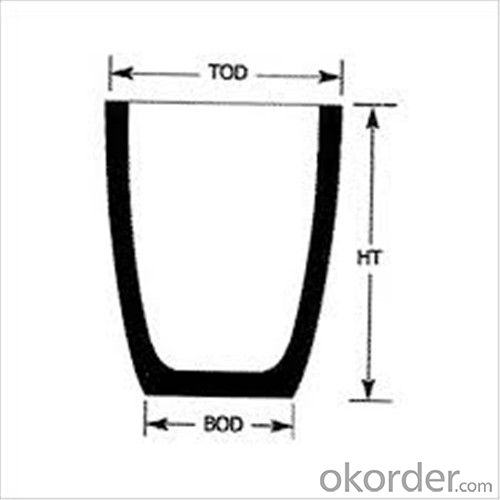
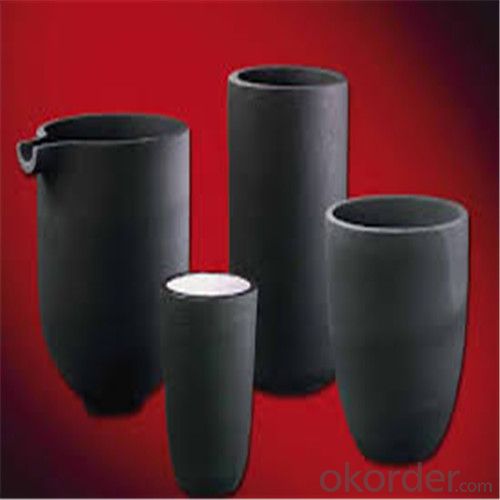
Physicochemical Properties of graphite crucible:
The crucible is an utensil or melting tank vessels that is made of refractory material (such as clay, graphite, quartz or difficult molten metal iron, etc.).
Graphite crucible, with is special advantages and Plasticity, is widely used in the smelting area, e.g. gold smelting, silver smelting, aluminum smelting, cooper smelting, etc.
high pure graphite | ||||
Item | Unit | baked twice | baked three time | baked four times |
impregnated once | impregnated twice | impregnated three times | ||
grain size | mm | ≤325μm | ≤325μm | ≤325μm |
Bulk density | g/cm3 | ≥1.68 | ≥1.78 | ≥1.85 |
Specific resistance | μΩ.m | ≤14 | ≤14 | ≤13 |
Bending strength | MPa | ≥25 | ≥40 | ≥45 |
Compressive strength | MPa | ≥50 | ≥60 | ≥65 |
Ash content | % | ≤0.15 | ≤0.1 | ≤0.05 |
Fine-grain Specialty Graphite FXG-1 | Fine-grain Specialty Graphite FXG-2 | ||||
Item | Unit | Guarantee value | Typical value | Guarantee value | Typical value |
Max grain size | mm | 0.8 | 0.8 | 0.8 | 0.8 |
Bulk density | g/cm3 | ≥1.70 | 1.73 | ≥1.73 | 1.76 |
Specific resistance | μΩ.m | ≤8.5 | 7.5 | ≤8.0 | 7 |
Bending strength | MPa | ≥10.0 | 11 | ≥12.0 | 12.5 |
Compressive strength | MPa | ≥24.0 | 27 | ≥31.0 | 34 |
Thermal Condcutivity | W/(m.k) | ≥120 | 150 | ≥130 | 160 |
C.T.E.(100-600) °C | 10-6/°C | ≤2.5 | 2.2 | ≤2.5 | 2.1 |
Ash content | % | ≤0.3 | 0.09 | ≤0.3 | 0.09 |
NO | Top diameter | Bottom diameter | Height | Tolerance | Capacity(Kg5%) |
2 | 90 | 50 | 55 | 2 | 0.3 |
3 | 105 | 80 | 93 | 2 | 0.5 |
4 | 102 | 80 | 100 | 2 | 0.6 |
5 | 112 | 82 | 130 | 2 | 0.8 |
6 | 120 | 82 | 141 | 2 | 0.9 |
8 | 138 | 90 | 153 | 2 | 1.2 |
12 | 148 | 100 | 181 | 2 | 1.8 |
16 | 156 | 110 | 190 | 2 | 2.3 |
20 | 180 | 120 | 230 | 2 | 3 |
25 | 186 | 128 | 248 | 2 | 3.7 |
Packaging & Shipping
Package: Wooden case and wooden pallet or pack as customer's requirement of graphite crucible.
Delivery time: depend on distance, usually 20 days to 50days after deposit of graphite crucible.
We can supply the products according to customer's drawings, samples and performance requirement.
Other Products
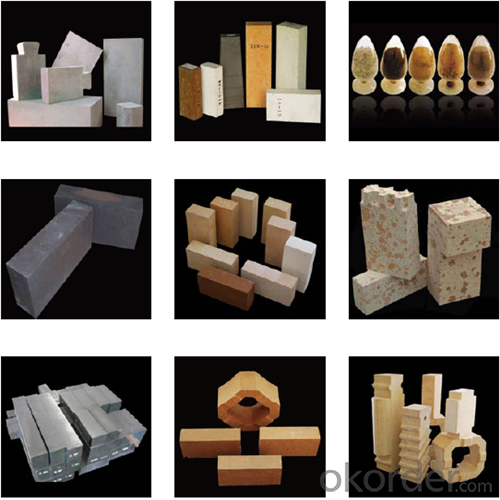
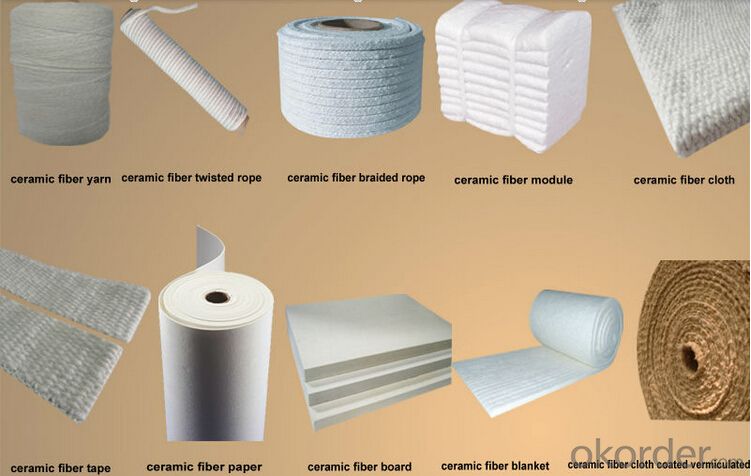
FAQ
1.What's your MOQ?
We will indicate the MOQ for each item in the quotation list. We accept the sample and trail order.
2.Can I negotiate the Prices?
Sure, we may consider discounts for bulk order of products.
3.How long will it take to complete my order?
For the stock items, we can arrange the shippment within 2~3days after received your payment. For the customized items, we will indicate the delivery time in the quotation list.
4.Can you give warranty of your products?
Yes, we extend a 100% satifisfaction guarantee on all items. Please feel free to provide timely feedback if you're not satisfied with N&D's Quality and Service. For the overseas orders, if there is a quality problem, please kindly to provide the picturers to show the problem by e-mail. We will provide the replacements to you at our cost according to actual conditions.
5.Can I visit you?
Sure. If you're a volume buyer and would like to visit our in-house products and production line, please contact us to make an appointment.
- Q: Can a graphite crucible be used for melting einsteinium?
- No, a graphite crucible cannot be used for melting einsteinium. Einsteinium is a highly radioactive element with a melting point of 860°C, whereas graphite has a much lower melting point of around 3,500°C. To handle and contain einsteinium safely, specialized materials and equipment designed for handling radioactive substances are required.
- Q: How should CPP aluminium plating film be produced?. Is the vacuum aluminizing machine necessary? How much is the machine?. What material does CPP aluminum plating film need?.
- The general use of Germany Leybold Vacuum aluminum plating machine, Italy Galileo system, domestic Shanghai Qingzhou Baofeng, Lanzhou Shuguang, vacuumThe required raw materials are CPP film, high-purity aluminum wire, graphite crucible and so on. You would like to know more about how to make CPP aluminized film. I suggest you go to the PP forum, and many of them are made of aluminized film
- Q: How to reduce the degree of oxidation of graphite when sintering at high temperature?
- Classification and cleaning of waste miscellaneous graphite plate, and the large burden burden with large surface area is packed in a press;
- Q: Can graphite crucibles be used for laboratory analysis?
- Yes, graphite crucibles can be used for laboratory analysis. Graphite is a commonly used material in laboratories due to its high temperature resistance and chemical inertness. It is especially useful for carrying out high-temperature processes, such as melting metals, as it can withstand temperatures up to 3000 degrees Celsius. Additionally, graphite crucibles have excellent thermal conductivity, allowing for even heat distribution during experiments. However, it is important to note that graphite crucibles may react with certain chemicals or elements under specific conditions, so it is crucial to consider the compatibility of the crucible material with the substances being analyzed. Furthermore, the choice of crucible material should also be based on the specific requirements of the analysis, as other materials like porcelain, quartz, or platinum may be more suitable in certain situations.
- Q: Can a graphite crucible be used for nickel melting?
- Yes, a graphite crucible can be used for nickel melting. Graphite is a suitable material for high-temperature applications and has good resistance to chemical reactions with nickel. It can withstand the high temperatures required for nickel melting without melting or reacting with the metal, making it an ideal choice for this purpose.
- Q: The difference between the graphite rod and graphite electrode, graphite and blank refers to what
- Graphite rod refers to graphite rod without processing. A graphite electrode refers to a finished product.
- Q: Is it often influenced by graphite tube replacement in atomic absorption furnace?
- Atomic absorption spectrometer (AAS) is composed of light source, atomization system, spectral system and detection system.The sharp line spectrum of the A light source as the light source requirements analyte emission of sufficient strength, stability, small background, generally using hollow cathode lamp, electrodeless discharge lamp.B atomizer (atomizer) can be divided into pre mixed flame atomizer (premixed flame atomizer), graphite furnace atomizer (graphite furnace atomizer), quartz furnace atomizer (quartz furnace atomizer), cathodic sputtering atomizer (cathode sputtering atomizer).
- Q: Are graphite crucibles suitable for melting alloys with low melting points?
- Yes, graphite crucibles are suitable for melting alloys with low melting points. Graphite has a high melting point and excellent thermal conductivity, allowing it to withstand high temperatures and efficiently transfer heat to the alloy. Additionally, graphite is chemically inert and does not react with most metals, making it an ideal choice for melting low melting point alloys.
- Q: Medium frequency furnace plus graphite crucible does not start
- Hello, my factory is specializing in the production of graphite crucible manufacturers, medium frequency furnace dedicated graphite crucible and so on
- Q: How to maintain the graphite crucible?
- Graphite crucible when in use must pay attention to whether there is a crack or graphite crucible itself is obvious, and must be regularly checked in graphite crucible after use, and must be a certain degree of cleaning of the graphite crucible in daily use
Send your message to us
Silicon Graphite Crucible for Melting Aluminium, Copper, Brass
- Loading Port:
- Shanghai
- Payment Terms:
- TT OR LC
- Min Order Qty:
- 1 pc
- Supply Capability:
- 1000 pc/month
OKorder Service Pledge
OKorder Financial Service
Similar products
Hot products
Hot Searches
Related keywords
